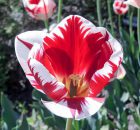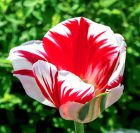Forget the roses, this year patriotic Islanders are stopping to ‘smell the tulips’
EDITOR’S NOTE: Following Sunday’s unexpected high winds, most of Manitoulin’s displays of the special Canada 150 tulips are just so many petals scattered in their gardens. For three weeks before that, though, these statuesque beauties that were popular plantings last fall stood tall and strong and were pleasant reminders of this special year. Laurentian University Professor Emeritus Dr. Joe Shorthouse has researched the development and marketing of this unique bloom.
by Dr. Joe Shorthouse, Professor
Emeritus, Laurentian University and summer resident at Batman’s Campground
MANITOULIN—Although spring seemed a long time coming this year, gardeners of Manitoulin Island are now being rewarded with a multitude of blossoms. One of the all-time spring favourites in Island flower gardens is the tulip and on the occasion of Canada’s 150th birthday, a new variety of tulip aptly named the ‘Canada 150 tulip’ or the ‘Maple Leaf tulip’ has stolen the show.
Selected by the National Capital Commission in Ottawa, and unveiled in May of 2016, the flowers of the Canada 150 tulip starting blooming in gardens and street-side planters throughout the Island about two weeks ago. This spectacular tulip has white blooms with red flame-like patterns that arise from the base of the petals that bear a striking resemblance to the Canadian flag.
Like most new varieties of tulips, the Canada 150 was bred in the Netherlands, but what also makes this tulip special is that it was brought to us by the Home Hardware stores as their contribution to the 150 birthday celebrations.
Home Hardware joined forces with a tulip-breeding company in the Netherlands, the National Capital Commission in Ottawa, and Communities in Bloom, a Canadian charity, to bring the bulbs to Canada. Home Hardware had the exclusive rights to selling the bulbs and last fall about 4 million were made available throughout the country in their 1,100 stores so their customers could enjoy them in the spring of 2017.
According to Terry Davis, the CEO of Home Hardware Stores Limited, “The company was proud to bring such a unique offering to our customers to celebrate an important milestone in Canada’s history.”
The Mindemoya Home Hardware Building Centre sold 44 packages of 25 bulbs and five packages of 100 bulbs over a two-week period. Stelle’s Home Hardware in Gore Bay had 23 packages of 25 bulbs each and sold them all in a few days.
The Manitowaning Mill Home Building Centre had about 3,200 bulbs. They sold 1,200 and gave away the rest to horticulture clubs and to Manitoulin Townships. Thanks to the Manitowaning store, the flowers now sway patriotically in a street-side planter outside the office of The Manitoulin Expositor in Little Current, and on main streets elsewhere.
The Canada 150 tulip adventure of my wife and I began last October when we purchased 25 bulbs. We carefully distributed the bulbs in five plastic pots, covered them with soil, then buried the pots in our flower garden in Sudbury. Come spring, we dug the pots out of the ground and on the first visit to our trailer at Batman’s Campground near Sheguiandah in May, we placed the pots on our patio.
About a week later, tips of the new tulip plants broke through the surface and we watched with anticipation as the fast growing plants started to produce leaves. Within a couple weeks, the long-stemmed stalks so characteristic of tulips started to form and by the third week in May, we had our first blooms.
Some interesting facts about tulips
Tulips are brightly coloured jewels of spring throughout Canada and a favourite of Manitoulin gardeners. They are indigenous to the mountain regions of Central Asia with temperate climates where winter temperatures are below freezing. Tulips need a period of cold dormancy, known as vernalization, in order to flower. They thrive in climates with cold winters, long, cool springs, and dry summers–making them perfect for the gardens of Manitoulin Island.
Wild tulips have a limited colour range of mostly reds and yellows and tend to have smaller flowers than the modern cultivars and hybrids with their strong colours and pastel shades.
Cultivation of tulips is thought to have begun in Persia in the 10th century. Bulbs were brought to Leiden in the Netherlands in 1594 and quickly became one of Europe’s favourite plants, rivalled only by roses and chrysanthemums. Tulips became symbols of imagination, dreaminess and a declaration of love.
By the 17th century, much of Europe and in particular the Netherlands, became so enamored by tulips, it triggered a speculative frenzy known as ‘tulipomania’ where the bulbs became so expensive they were treated as a form of currency. To this day, tulips are associated with the Netherlands where cultivated forms are often called ‘Dutch tulips.’ Huge numbers of tulips are grown commercially each year in the Netherlands and their bulbs are exported throughout the world.
Tulips belong to the lily family Lilaceae and their large six-petal flowers, about the size of a tea-cup, appear singularly at the ends of long stems. The multi-coloured patterns of modern varieties result from breeding; they normally have solid, not feathered borders between the colours.
The sturdy stems of tulips allow them to stand up to windy conditions that are common across Canada in May. They make excellent cut flowers and have a long vase life. Tulips usually have two to six large leaves that form in a rosette at ground level.
Tulips are perennials that grow from bulbs in the spring. Tulips can also be obtained from seeds, but if often talks 5-8 years before plants from seeds are of a flowering size. Plant breeders have produced about 3,000 different varieties. Growing tulips from bulbs is by far the easiest for most gardeners.
Tulips propagate themselves in an asexually manner by growing small bulblets which form next to the original bulb. Because the bulblets grow from the parent plant, they produce the exact same flower type and colour. Once a bulb produces a flower, it forms new bulblets by cloning, and then it shrivels and disintegrates.
Propagation is best left for the plant breeders who cross-pollinate flowers and produce seeds of new varieties such as the Canada 150. Commercial growers harvest the newly formed bulbs in the late summer and package them for sale in late summer or early fall. Bulbs are typically planted around late summer and fall in well-drained soils.
Observant gardeners will notice that tulips are rarely visited by insects. This is because tulips are not pollinated by insects, but instead pollinate themselves. Tulips do not produce nectar and this is why they are not visited by butterflies.
Tulips are not only a traditional sign of spring in the gardens across Canada, they have become a powerful symbol of international friendship between Canada and the Netherlands.
This friendship began in the Second World War when the Dutch Royal Family took refuge in Ottawa during the Nazi occupation of their country. Princess Margriet Francisca was born in the Ottawa Civic Hospital in 1943 during the exile.
Of interest, the maternity ward was declared a temporary part of Dutch territory so that Princess Margriet was born in the Netherlands and would inherit her Dutch citizenship from her mother. The Canadian government even changed the flag over the Parliament building to the Dutch flag the day of her birth.
In addition to protecting members of the Dutch Royal family, Canadian troops later played a pivotal role in liberating the Netherlands from Nazi occupation. As a means of thanking the people of Canada for their generosity, the Royal Family sent a thank-you gift of 100,000 tulips at the end of the Second World War and continues to do so annually.
The arrival of tulip bulbs each year resulted in establishment of the Canadian Tulip Festival in 1953 as a way of celebrating the Dutch gift. Tulips became Ottawa’s official flower and the annual festival has become one of the largest floral displays in the world.
2016 marked the 65th tulip festival in Ottawa where 300,000 Canada 150 bulbs were donated by the Netherlands for planting in the flowerbeds of the National Capital Commission last fall such that they flowered proudly over the past two weeks.
Tips for growing tulips
Tulips are perennial plants, but most gardeners grow them as annuals, planting new bulbs every autumn, since the climate of southern Canada can’t replicate the Asian conditions where tulips originated.
Bulbs are their own complete storage system and contain all the nutrients they need for one year. Each bulb only flowers once, but before the above surface parts of the plant die by early summer, the plant produces new bulblets. New bulbs produced by the mother plant can be dug up, but they are often much smaller than those purchased from commercial growers in the fall.
Bulbs should be planted deep in the soil in mid fall (October) before a hard frost is expected. Choose sites in your garden with full or afternoon sun. Soil should be well-drained, fertile and dry.
Plant bulbs about 10 to 15 cm apart and about 20 cm deep measured from the base of the bulb. The bigger the bulb, the deeper the hole it needs. Set the bulbs with the pointy end up in a hole made by your trowel. Cover with soil and press firmly.
Water tulips during dry spells in the fall, but otherwise, do not water since water logged soil kills tulip bulbs.
Deadhead tulips after they flower to prevent them from producing seeds. If you plan on regrowing tulips from the bulbs you bought the previous year, the new bulbs formed by the mother plant should be dug up and removed from your flower beds.
Remove the soil from the bulbs, then placed them in a paper bag in the crisper of your refrigerator. Don’t place them with apples since apples give off ethylene gas which helps fruit ripen, but kills the flowers inside tulip bulbs. Don’t put tulip bulbs in the freezer as it will kill them.
Bulbs obtained in this manner are usually smaller than the original mother bulb and produce smaller flowers. Most gardeners find it best to leave the production of new bulbs to the commercial growers and simply buy and plant new bulbs each fall.






